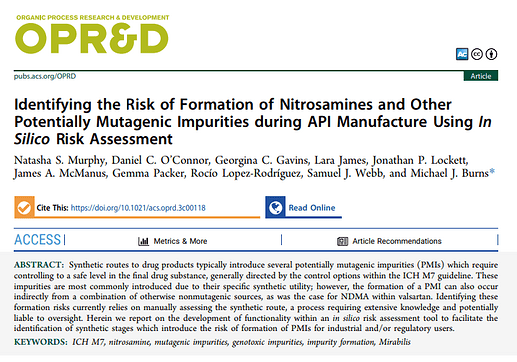The start of the ‘nitrosamine saga’ can be traced back to the synthesis of Valsartan. Chemical syntheses are complex affairs with many conflicting aspects to be balanced.
Could the use of in silico methodology identify potential risks associated with the unintentional formation of PMIs during synthesis?
A publication by @MichaelBurns Burns et al. “Identifying the Risk of Formation of Nitrosamines and Other Potentially Mutagenic Impurities during API Manufacture Using In Silico Risk Assessment”
Access: https://pubs.acs.org/doi/10.1021/acs.oprd.3c00118
Abstract:
Synthetic routes to drug products typically introduce several potentially mutagenic impurities (PMIs) which require controlling to a safe level in the final drug substance, generally directed by the control options within the ICH M7 guideline. These impurities are most commonly introduced due to their specific synthetic utility; however, the formation of a PMI can also occur indirectly from a combination of otherwise nonmutagenic sources, as was the case for NDMA within valsartan. Identifying these formation risks currently relies on manually assessing the synthetic route, a process requiring extensive knowledge and potentially liable to oversight. Herein we report on the development of functionality within an in silico risk assessment tool to facilitate the identification of synthetic stages which introduce the risk of formation of PMIs for industrial and/or regulatory users.
